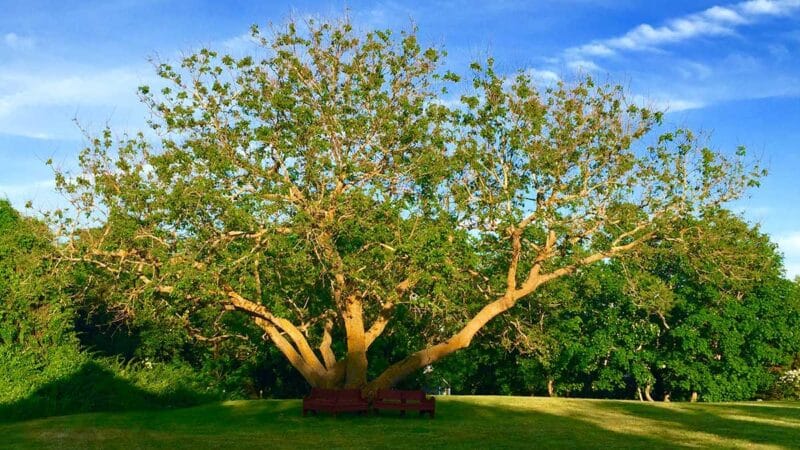Late Fall, Warm Winters, Early Springs
by Dr. Sarah Treanor Bois, PhD
Director of Research & Education at the Linda Loring Nature Foundation
Many of us have been enjoying the mild autumn we’ve had on Nantucket this year with end-of-summer temperatures lingering well into the end of September. Forget “sweater weather”: it’s been more like shorts and t-shirts into October. Even now, in mid-November, we’ve had some 60-degree days and only recently had our first frost. It’s enough to think autumn has moved into winter’s territory.
This may seem like an anomaly, but this is just one year in a pattern of longer, late summers, abbreviated winters, and early spring temperatures. We know in New England that temperatures are rising at rates faster than in other parts of the country. And, for a place known for its seasonality, these temperatures can result in changes to seasonal timing. While the summer growing season is expanding, winters are getting warmer and shorter, resulting in reduced winter ice cover, low, if any, snow pack, and earlier spring leaf out.
Sometimes called “season creep,” what we’re seeing is observed changes in the timing of the seasons such as earlier indications of spring widely observed in temperate areas across the Northern Hemisphere. Season creep happens for autumn, with warmer temperatures extending the growing season.
Season creep is an example of how small changes can have a big impact. Climate change disrupts the critically important timing of natural events (also known as phenology), such as snow melt and spring bloom, upon which ecosystems depend. These changes affect the timing of many lifecycle events, such as when flowers bloom or when pollinators emerge. Changes in the timing of these events—spring thaw or songbird migration, for example—can have adverse effects on ecosystems because different species may respond to different environmental cues, resulting in a misalignment between species that may rely on one another.
These warm autumns can be confusing for plants ready to go to bed for the winter. There have been more than a few reports of cherry tomato plants on Nantucket producing fruit well into the fall. At my own house, a lavender plant (a small shrub) sent up new flower stalks and started flowering again in October. Lavender is usually finished flowering in mid-to-late summer. While these observations may be a boon to gardeners, warmer fall temperatures have other effects on our vegetation.
Late onset of flowers or second bloom periods may be beneficial to the plant in the short term, but the energy resources required to flower may be greater than the benefit. If a flower that normally blossoms in the summer blooms in the fall, will it be pollinated? Will it have time to set seed before a frost?
Another consequence we may see is with our fall colors. The longer nights and cooler days of autumn also typically jump-start the seasonal color change, known as leaf senescence. Trees and other deciduous plants respond to the difference in temperature, precipitation, and light by slowing photosynthesis.
As the chlorophyll—the energy-producing compound that makes leaves green—breaks down, new chemical compounds emerge. Carotenoids, the same pigments in carrots and buttercups, make leaves appear orange, yellow, and amber. Some tree species also produce anthocyanins, compounds found in blueberries and grapes, giving leaves red, purple, and burgundy tones. These are the compounds that create the color palette of a New England autumn.
Nantucket is not usually known for its fall foliage display. Many islanders escape to Vermont, New Hampshire, and western Massachusetts for leaf-peeping a typical New England fall display.
Researchers are now finding that hardwood forests in the Northern Hemisphere are holding their green leaves for more than a week longer. Moderate heat and drought extend the growing season and delay leaf senescence. Stressed trees tend to go right from green to brown. But extreme drought exacerbated by high heat—the exact conditions seen in New England last summer—can accelerate senescence, causing leaves to change earlier and faster.
These responses are species-specific, with each tree species responding uniquely to the various weather and climatic patterns. Scientists note that during some years, certain trees will turn color early while others will delay and turn color later. So instead of having this explosion of fall color over a short time, we might get different groups of trees turning color over an extended period.
A recent paper by Beil et al. phrased it like this: “Late to bed, late to rise— Warmer autumn temperatures delay spring phenology by delaying dormancy.” They found that plants that experienced late fall warming had delayed spring leaf out. Basically, the plants had used up some of their energy stores in trying to flower again, stay green, or other energy-taxing activities in the fall. Without a proper dormancy, the changes in nutrient resorption impacted production in the following year, at least in early spring, because the construction of new foliage relies almost exclusively on nutrients resorbed from foliage during the preceding leaf fall.
And it’s not just autumn or spring events that are affected. Unusually warm weather during late winter can create a “false spring” that triggers the new growth of plants to begin too early, leaving them vulnerable to any subsequent frosts. Since some plants are highly vulnerable to frost damage, this can significantly impact the fruit, nut, or seed production of frost-affected plants.
We know that New England is expected to experience more warm temperatures in the coming decades, even under the most conservative climate change scenarios. So, what are we doing about it?
On Nantucket, the Linda Loring Nature Foundation has a phenology research project investigating the response of climate change (primarily through temperatures and precipitation) on native shrub phenology. We tend to focus our analysis on spring phenology, but we also collect data in the fall on leaf color change and leaf drop for eight different woody species. We don’t have any synthesis of the fall data yet, but recording these observations now will help us observe changes as they happen.
Have you witnessed any “season creep” this fall or early winter? We’d love to see some photos and share your observations. Flowers in November? Garden plants that just kept going? Any December daffodils?
Interested in learning more and potentially contributing? Keep an eye out at llnf.org for upcoming phenology workshops and research results.



